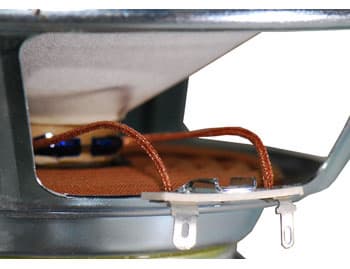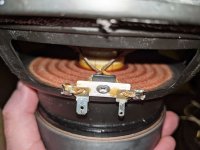someone in the family (carries half of my genes) run our trustworthy and reasonably loud Logitech z-2300 2.1 system (with smallish 2-way speakers instead of the original satellites have have gone past their useful service life a long time ago) at a small party for multiple hours at full volume and at some point it lost the bass output altogether.
He got back home and I wanted to see what had failed. The amp board looked fine (no obvious burn marks or signs of magic smoke), the 8" driver in the subwoofer looked fine. There was just a tiny bit of sound coming from the subwoofer and the heatsink of the amp board got rather warm rather quickly.
I had a closer look at the element and checked it with a multimeter: it showed it was practically short circuited, which certainly makes for a bad speaker driver. However, the place of the short circuit was a surprise to me.. the tinsel wires going from the connectors to the voice coil were touching each other quite close to the connector side. There seems to be more slack in them than I would have expected and I would have expected them to have some kind of insulation on them. Perhaps it was brushed off with the friction from repeated contact or perhaps it was running too hot or something.
Separating them brought the sound back, now I just need to make sure that won't happen again. I was glad to find out the amp didn't mind the short circuit. The Z-2300 is not exactly an audiophile device but for this purpose it works fine and can take a lot of beating (usually).
He got back home and I wanted to see what had failed. The amp board looked fine (no obvious burn marks or signs of magic smoke), the 8" driver in the subwoofer looked fine. There was just a tiny bit of sound coming from the subwoofer and the heatsink of the amp board got rather warm rather quickly.
I had a closer look at the element and checked it with a multimeter: it showed it was practically short circuited, which certainly makes for a bad speaker driver. However, the place of the short circuit was a surprise to me.. the tinsel wires going from the connectors to the voice coil were touching each other quite close to the connector side. There seems to be more slack in them than I would have expected and I would have expected them to have some kind of insulation on them. Perhaps it was brushed off with the friction from repeated contact or perhaps it was running too hot or something.
Separating them brought the sound back, now I just need to make sure that won't happen again. I was glad to find out the amp didn't mind the short circuit. The Z-2300 is not exactly an audiophile device but for this purpose it works fine and can take a lot of beating (usually).
Attachments
Those wires don't usually have insulation, they are special and must have slack, as they constantly flex.
sure, I understand the need for slack but given what happened that feels like a bit too much slack to me (or a non-optimal placement of the connector and/or voice coil connection)
Anyways, I was happy to see it wasn't a permanent failure while the reports I originally received indicated otherwise.
Anyways, I was happy to see it wasn't a permanent failure while the reports I originally received indicated otherwise.
^^^^^that.
Your speaker was POORLY assembled and that is an understatement.
Tinsel wires NEED a lot of slack, but (as shown in these pictures) they move a lot up-down (say 6-12 mm) and a little sideways (a couple mm) , so it´s enough that they are set parallel by the assembler, so typical 15-25mm separation is safe.

Yours are an accident waiting to happen (and it finally happened)
Use a plastic body ballpoint pen, or a pencil, and carefully run it along each wire a couple times, so you "iron" it outwards, you want them to take this shape: () and not the current )(
Again, don´t overdo it, don´t tear them off the cone or something.
Your speaker was POORLY assembled and that is an understatement.
Tinsel wires NEED a lot of slack, but (as shown in these pictures) they move a lot up-down (say 6-12 mm) and a little sideways (a couple mm) , so it´s enough that they are set parallel by the assembler, so typical 15-25mm separation is safe.

Yours are an accident waiting to happen (and it finally happened)
Use a plastic body ballpoint pen, or a pencil, and carefully run it along each wire a couple times, so you "iron" it outwards, you want them to take this shape: () and not the current )(
Again, don´t overdo it, don´t tear them off the cone or something.
The lead-in wires should never be able to touch. Unfortunately this assembly error is not that uncommon.
Shorten each lead-in wire by a couple of mm so they cannot touch. Use a soldering iron and a pair of tweezers to feed a bit of each wire through the tag strip.
Shorten each lead-in wire by a couple of mm so they cannot touch. Use a soldering iron and a pair of tweezers to feed a bit of each wire through the tag strip.
Sloppy driver build.
Desolder at the terminals, pull the wire thru a bit more and resolve. clip off the excess.
dave
Desolder at the terminals, pull the wire thru a bit more and resolve. clip off the excess.
dave
pulled the wires through the terminal a bit and the subwoofer has now been taken back into active use with great success.
a 15 inch driver I got for another project has a superior construction also in this regard (lead-in wires going out in opposite directions from the terminals and then bending back to the cone.
a 15 inch driver I got for another project has a superior construction also in this regard (lead-in wires going out in opposite directions from the terminals and then bending back to the cone.
I've used Solder-Wick to repair a broken tinsel lead, after removing the flux from it using acetone. Removing the flux made it more flexible. That was in 1977. The speaker is still functional. It is a JBL, K series I think, 15" musical instrument loudspeaker which I got for next to nothing due to the broken lead.
Very clear the tinsel leads shorted. And a safe fix for a 2.1.
Logitech are generally safe hands in PC speakers. Albeit at the cheap end of the market.
My current Logitech Z200 PC speakers:
https://www.novatech.co.uk/products/logitech-z200-2-0-speaker-system-black/980-000810.html
Good at the price. And all the advantages of twin drivers. 😀
Logitech are generally safe hands in PC speakers. Albeit at the cheap end of the market.
My current Logitech Z200 PC speakers:
https://www.novatech.co.uk/products/logitech-z200-2-0-speaker-system-black/980-000810.html
Good at the price. And all the advantages of twin drivers. 😀
Attachments
But leave enough slack for full excursion. Or, rrrrip! I’ve seen that assembly error happen too. Resulted in an entire production run of OEM drivers being dumped on the surplus market, which I cashed in on. But I had to re-lead the 12 I bought. Would have eventually failed in the field without it. If you de-solder, rotate the wire so it naturally wants to point the other way. Might be able to re-train it as Mr Fahey suggests, but if you just bend it and put it back in its enclosure it will go back to its old bad habits.Sloppy driver build.
Desolder at the terminals, pull the wire thru a bit more and resolve. clip off the excess.
dave
- Home
- Member Areas
- The Lounge
- unusual failure mode for a speaker driver (at least for me)

